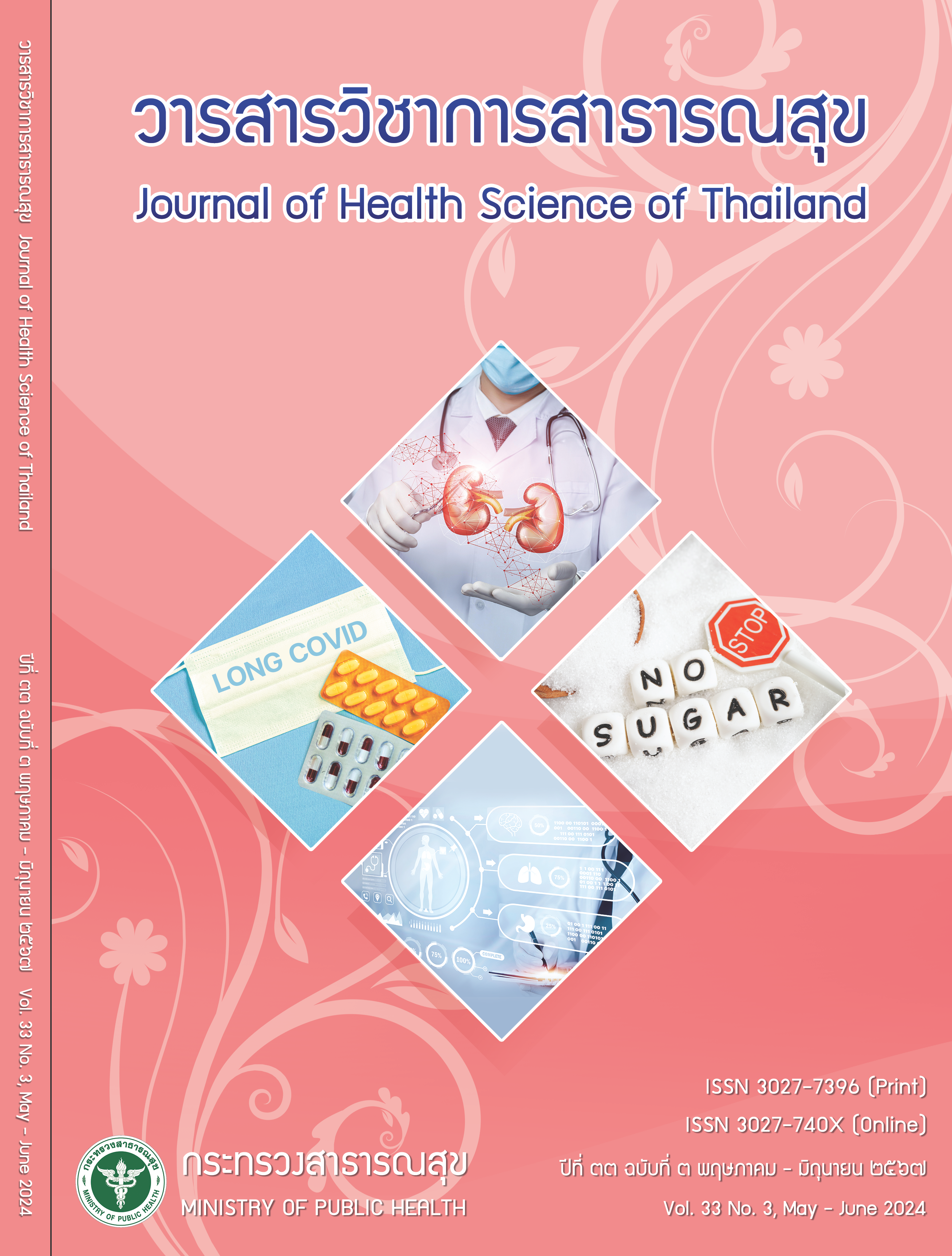Development of Telemedicine Service Model, Prachuap Khiri Khan Province
Keywords:
telemedicine, technology acceptance model, six building blocks, patient satisfactionAbstract
This study is research and development with the objectives to (1) study the situation and models of telemedicine services in Prachuap Khiri Khan Province during the years 2022-2024, (2) develop service models, and (3) evaluate the developed service models. The tools used for the study were developed from the Technology Acceptance Model theory combined with the six building blocks of health system framework. The study was divided into three phases. In Phase 1, the development began using the quality management cycle, which included work planning, creating work methods, implementation, and performance evaluation. It was found that only 3 out of 8 hospitals had service performance. Phase 2 involved improving the work models using the quality management cycle, carrying out activities based on work promotion measures derived from focus group discussions with stakeholders. These measures included setting departmental and managerial performance targets, awarding outstanding performers, involving executive personnel in listening, solving problems, and regularly monitoring operations, knowledge exchange between model hospitals, empowering visits to all hospitals, and instilling confidence in personnel to see the benefits and understand that telemedicine is not difficult to implement. Phase 3 involved evaluating the developed service model by assessing: (1) volume and access to services, finding that the average number of service instances per month increased by 5.83 times and was applied to more illnesses; (2) the relationship between variables using Spearman Sign rank test, which found that the levels of perceived ease of use, perceived usefulness overall, and perceived benefits of telemedicine in relation to the six building blocks of health system framework had a positive correlation with the intention to use at a confidence level of 0.05. The Biserial correlation was used to test the relationship between staff’s intention to use and their actual usage behavior post-development, showing a positive correlation at a confidence level of 0.05. The Wilcoxon sign ranks test evaluated the levels of perceived benefits, perceived ease of use, and intention to use before and after development, and showed that all variables had significantly increased scores at a confidence level of 0.05. Lastly, patient satisfaction was found to be at a high to highest level. The study concludes that the theoretical framework can explain the behaviors and variables studied, and the developed model used for improving services was effective.
Downloads
References
วรธา มงคลสืบสกุล. การเข้าถึงบริการทางสาธารณสุขของ ไทย: ภาพสะท้อนและความเหลื่อมล้ำของกลุ่มเปราะบางทาง สังคม. วารสารมนุษยศาสตร์และสังคมศาสตร์ มหาวิทยาลัย เอเชียอาคเนย์ 2565;6(1):55-68.
ศูนย์เทคโนโลยีสารสนเทศและการสื่อสาร สำนักงานปลัด กระทรวงสาธารณสุข. ยุทธศาสตร์สุขภาพดิจิทัลกระทรวง สาธารณสุข (2564-2568) [อินเทอร์เน็ต]. [สืบค้นเมื่อ 31 พ.ค. 2566]. แหล่งข้อมูล: https://ict.moph.go.th/upload_file/files/97c2287c8f04e13f81fec13e431e7a5e. pdf
AMARIN 34 HD. ธุรกิจ Telemedicine โตพุ่ง! หนุนราย ได้โรงพยาบาลเอกชนเกือบ 6 พันล้านบาท [อินเทอร์เน็ต]. 2564 [สืบค้นเมื่อ 10 มิ.ย. 2566]. แหล่งข้อมูล: https:// www.amarintv.com/spotlight/business-marketing/detail/42489]
กระทรวงสาธารณสุข. ตัวชี้วัด: จังหวัดที่มีบริการการแพทย์ ทางไกลตามเกณฑ์ที่กำหนด. ตัวชี้วัดการตรวจราชการ ปี งบประมาณ 2566. ต.ค.2566. นนทบุรี: กระทรวงสาธารณสุข; 2566.
Davis FD. Perceived usefulness, perceived ease of use, and user acceptance of information technology. MIS Quarterly 1989;13(3):319–40.
ปราโมทย์ ลือนาม. แนวความคิด และวิวัฒนาการของแบบ จำลองการยอมรับการใช้เทคโนโลยี. วารสารการจัดการสมัย ใหม่ [อินเทอร์เน็ต]. 2566 [สืบค้นเมื่อ 31 พ.ค. 2566]. แหล่งข้อมูล: https://so04.tci-thaijo.org/index.php/ stou-sms-pr/article/view/11933
ภูวนาท เช้าวรรณโณ, สวรส ศรีสุตโต, วิษณุ เหลืองลออ. การ ศึกษาแรงจูงใจและการยอมรับเทคโนโลยีของคนไข้ทีมีผลต่อ การตัดสินใจใช้โทรเวชกรรมของโรงพยาบาลเฉพาะทางด้าน กระดูกสันหลัง. การประชุมวิชาการระดับชาติ ครั้งที่ 14. วัน ที่ 7-8 กรกฎาคม 2565; มหาวิทยาลัยราชภัฎนครปฐม จังหวัดนครปฐม. นครปฐม: มหาวิทยาลัยราชภัฎนครปฐม; 2565
อรพรรณ คงมาลัย, วสันต์ ใจวงศ์. การยอมรับและการนำ ระบบโทรเวชกรรมเข้าไปกับกระบวนการสาธารณสุขในพื้นที่ ห่างไกล กรณีศึกษา : โรงพยาบาลสมเด็จพระยุพราชเชียงของ จังหวัดเชียงราย. วารสารวิจัยและพัฒนา มจธ 2560; 40(4):641-50.
ธนพร ทองจูด. การศึกษาปัจจัยของการตรวจรักษาด้วยโทร เวชกรรมที่มีผลต่อทัศนคติและความตั้งใจ เลือกใช้บริการโทรเวชกรรมของผู้รับบริการของโรงพยาบาลรามาธิบดี. [สารนิพนธ์ปริญญาการจัดการมหาบัณฑิต]. นครปฐม: มหาวิทยาลัยมหิดล; 2564.
Tsai CH. Integrating social capital theory, social cognitive theory, and the technology acceptance model to explore a behavioral model of telehealth systems. International Journal of Environmental Research and Public Health. 2014;11(5):4905–25.
Kamal SA, Shafiq M, Kakria P. Investigating acceptance of telemedicine services through an extended technology acceptance model (TAM) [Internet]. 2019 [cited 2023 Jun 18]. Available from: https://doi.org/10.1016/j. techsoc.2019.101212
Jack SM, Griffiths UK, Closser S, Burchett H, Marchal B. Measuring the health systems impact of disease control programmer: a critical reflection on the WHO building blocks framework. BMC Public Health 2014;14(1): 278.
Downloads
Published
How to Cite
Issue
Section
License
Copyright (c) 2024 Ministry of Public Health

This work is licensed under a Creative Commons Attribution-NonCommercial-NoDerivatives 4.0 International License.







